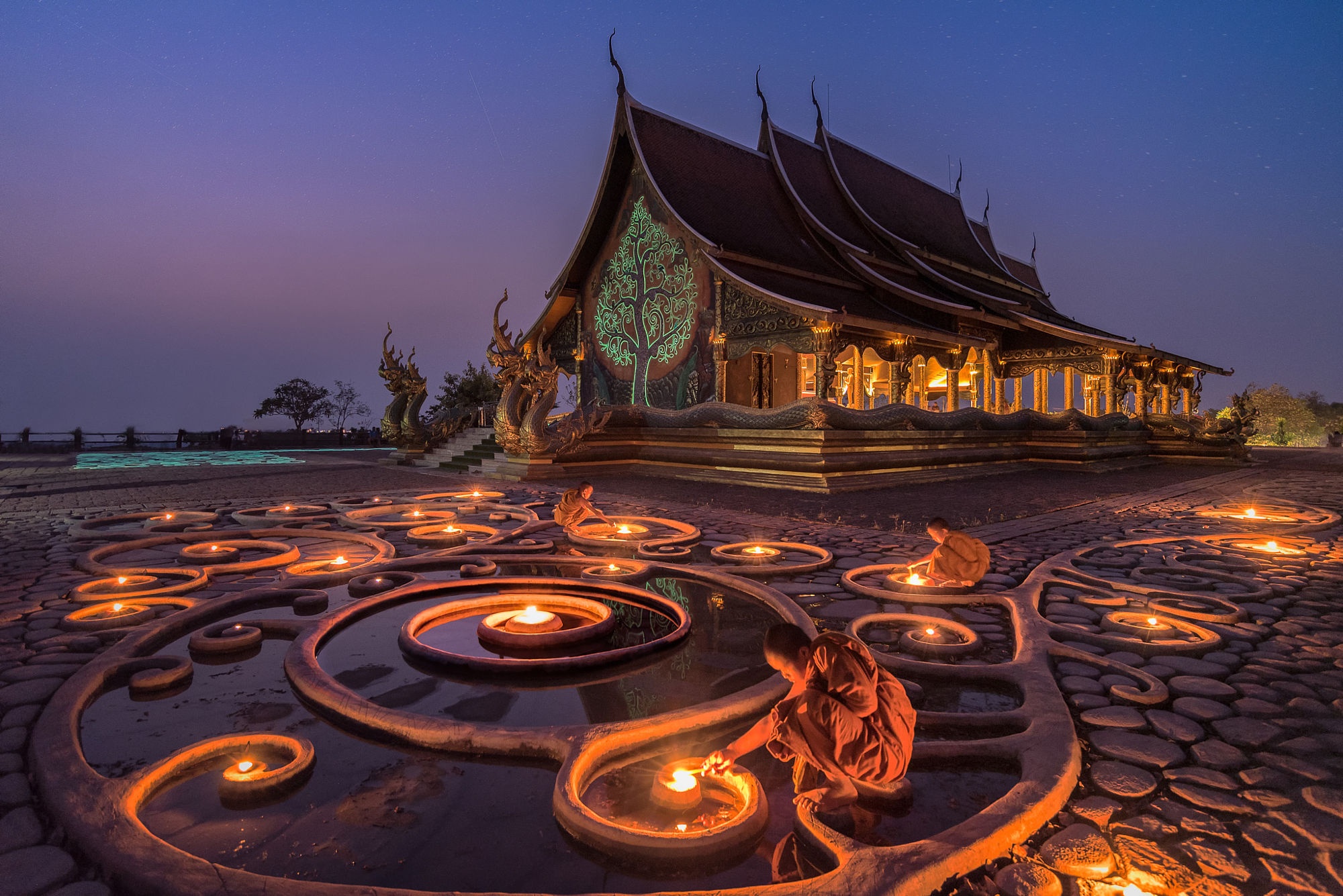
Landscape and Architecture Management of Thai Temples for Faith Fostering: Past to Present
ดร.วสุ โปษยะนันทน์
Dr.Vasu Poshyanandana
บทคัดย่อ
การวิจัยเรื่อง “การจัดการภูมิทัศน์และสถาปัตยกรรมของวัดไทยให้เกิดความเจริญศรัทธา : จากอดีตสู่ปัจจุบัน” นี้ เกิดขึ้นจากความต้องการที่จะแก้ไขปัญหาที่เกิดขึ้นในสถานการณ์ปัจจุบันกับวัดไทยใน พระพุทธศาสนา ทางด้านที่เกี่ยวข้องกับลักษณะทางกายภาพและความเจริญศรัทธาที่ลางเลือนไปจากอดีตที่วัดไทยเคยเป็นที่พึ่งทั้งทางกายและทางใจ นอกจากนั้นยังเป็นตั้งแต่แหล่งศึกษาหาความรู้ ไปจนถึงการเป็นที่ประกอบพิธีฌาปนกิจ การวางผังกำหนดรูปแบบทางสถาปัตยกรรมและภูมิ สถาปัตยกรรมในอดีต เป็นภูมิทัศน์ตามประเพณีของพระพุทธศาสนา ตามสภาพภูมิอากาศภูมิประเทศ และประโยชน์ใช้สอยตามสภาพสังคมในสมัยนั้นๆ โดยได้คำนึงถึงความสง่างาม ความเด่นชัด ความเป็นปูชนียสถาน วัดจึงเป็นที่เจริญศรัทธาของคนไทยในอดีต ในปัจจุบันสังคมได้เปลี่ยนแปลงไป การใช้พื้นที่และการก่อสร้างอาคารในวัดจึงขาดหลักการต่างๆดังกล่าว มีการใช้พื้นที่เพื่อหารายได้มากขึ้น ในขณะที่ไม่มีการวางวางแผนจัดระเบียบการก่อสร้างที่คำนึงถึงภูมิทัศน์ของสถานที่ ก่อให้เกิดความเสียหายต่างๆ ทำให้พื้นที่วัดที่ใช้เพื่อการเจริญศรัทธาสูญหายไปมาก
จึงจำเป็นที่จะต้องหาวิธีการจัดการให้วัดไทยในปัจจุบันยังคงรักษา หรือปรับปรุงแก้ไข ภูมิทัศน์ ด้วยการกำหนดหลักเกณฑ์ต่างๆ คำแนะนำเรื่องควรหรือไม่ควรในการก่อสร้างอาคารในวัด เพื่อเป็นแนวทางให้หน่วยงานที่เกี่ยวข้องนำข้อกำหนดหรือหลักเกณฑ์เหล่านั้นไปสู่การปฏิบัติ เพื่อไม่ให้วัดดูเสื่อมโทรม รกรุงรัง ไม่น่าเจริญศรัทธา
ทั้งนี้ได้กำหนดวัตถุประสงค์ของโครงการไว้เพื่อศึกษาเปรียบเทียบสภาพภูมิทัศน์ของวัดไทยระหว่างในอดีตและในปัจจุบัน เพื่อศึกษาเงื่อนไขที่สภาพภูมิทัศน์และสถาปัตยกรรมภายในวัด ก่อให้เกิดความเจริญศรัทธาในพระพุทธศาสนา และประมวลปัญหาต่างๆที่เกิดขึ้นกับวัดไทย ในบริบทของแนวคิดทางพระพุทธศาสนา แนวทางในการอนุรักษ์ในฐานะมรดกทางวัฒนธรรมของกรมศิลปากร ซึ่งพัฒนามาจากการผสมผสานแนวทางสากลกับวัฒนธรรมประเพณีของไทย และความคิดเห็นของพุทธศาสนิกชนในปัจจุบัน ให้นำมาซึ่งหลักเกณฑ์และข้อแนะนำในการบริหารจัดการภูมิทัศน์และสถาปัตยกรรมของวัดไทยให้ยังคงความเจริญศรัทธาในปัจจุบัน ที่เน้นในเรื่องของการตระหนักในคุณค่าของสถานที่แห่งความเจริญศรัทธา ปฏิบัติตามกฎหมาย และระเบียบต่างๆที่มีอยู่แล้ว มีการควบคุมถือปฏิบัติอย่างจริงจัง มีการวางแผนจัดการในภาพรวมอย่างเป็นระบบด้วยความร่วมมือจากสายวิชาการต่างๆที่เป็นมืออาชีพ ในหลักการของธรรมภิบาลและการมีส่วนร่วม ให้สมกับความเป็นมรดกวัฒนธรรมที่เป็นของส่วนรวมซึ่งทุกคนมีสิทธิ์เป็นเจ้าของ
Abstract
The research “Landscape and Architecture Management of Thai Temples for Faith Fostering: Past to Present” has resulted from the requirement to solve problems which Thai Buddhist temples are currently facing concerning the physical features and the decreasing of faith. In the past, Thai temples were dependable to people, both physically and mentally, from being places of learning to places of cremation. The planning and design of architecture and landscape architecture were based on Buddhist traditions, climate, topography and functional requirements that served the society of the time, characterized by dignity, prominence and spirit of place of worship, thus temples were places that originated and inspired faith of the people in the past. At present, however, social changes have resulted in different uses until buildings in temples have lost their original principles but tend to serve the purpose of income generation. Planning as well, has neglected the appropriate landscape design order, causing damages in various aspects, especially the faith enhancement value of the place.
It is, therefore, necessary to find means to manage Thai temples in order to preserve or improve the landscape based on determination of principles and setting building guidelines, which can be used by involving organizations in the implementation to prevent the decay and disorder of the place, leading to decrease of faith.
The objectives of the research comprise : comparative study of landscape of Thai temples in the past and the present in order to understand the landscape and architectural factors that affect the origination and inspiration of faith in Buddhism; collection and summary of problems occurred in Thai temples in the contexts of Buddhist concepts, means of conservation as cultural heritage in the responsibility of the Fine Arts Department that has developed from the integration between international concept and Thai culture and traditions and current opinions of Buddhists. The research is expected to result in principles and recommendations for management of landscape and architecture of Thai Temples to enhance faith, emphasizing on the awareness of the values of place of worship, respect of laws and regulations, active and effective control and implementation, systematic management planning in cooperation with multi-professional parties. These are, essentially and necessarily, based on good governance and participation for the highest benefits of the cultural heritage which belongs to all people.